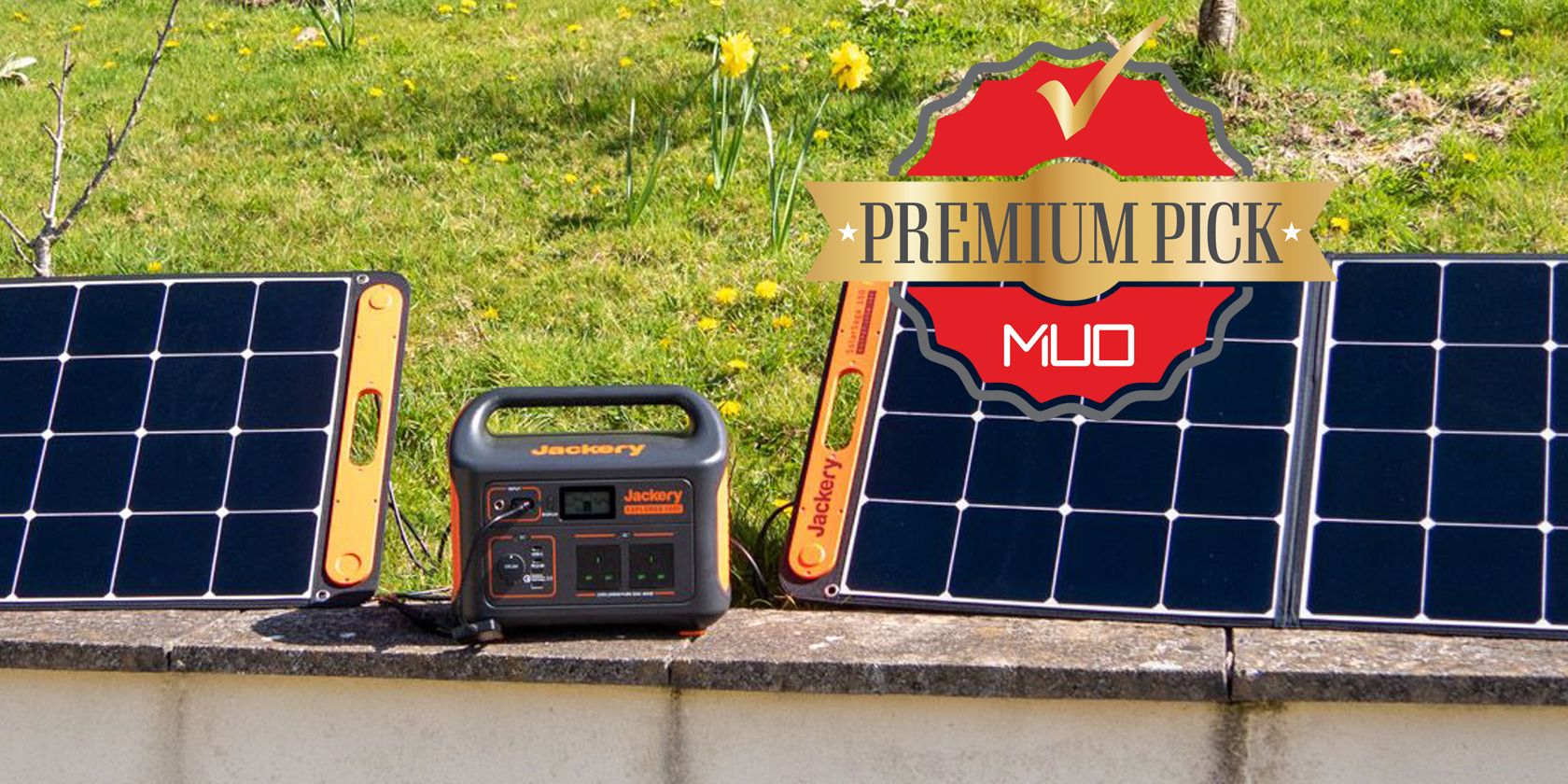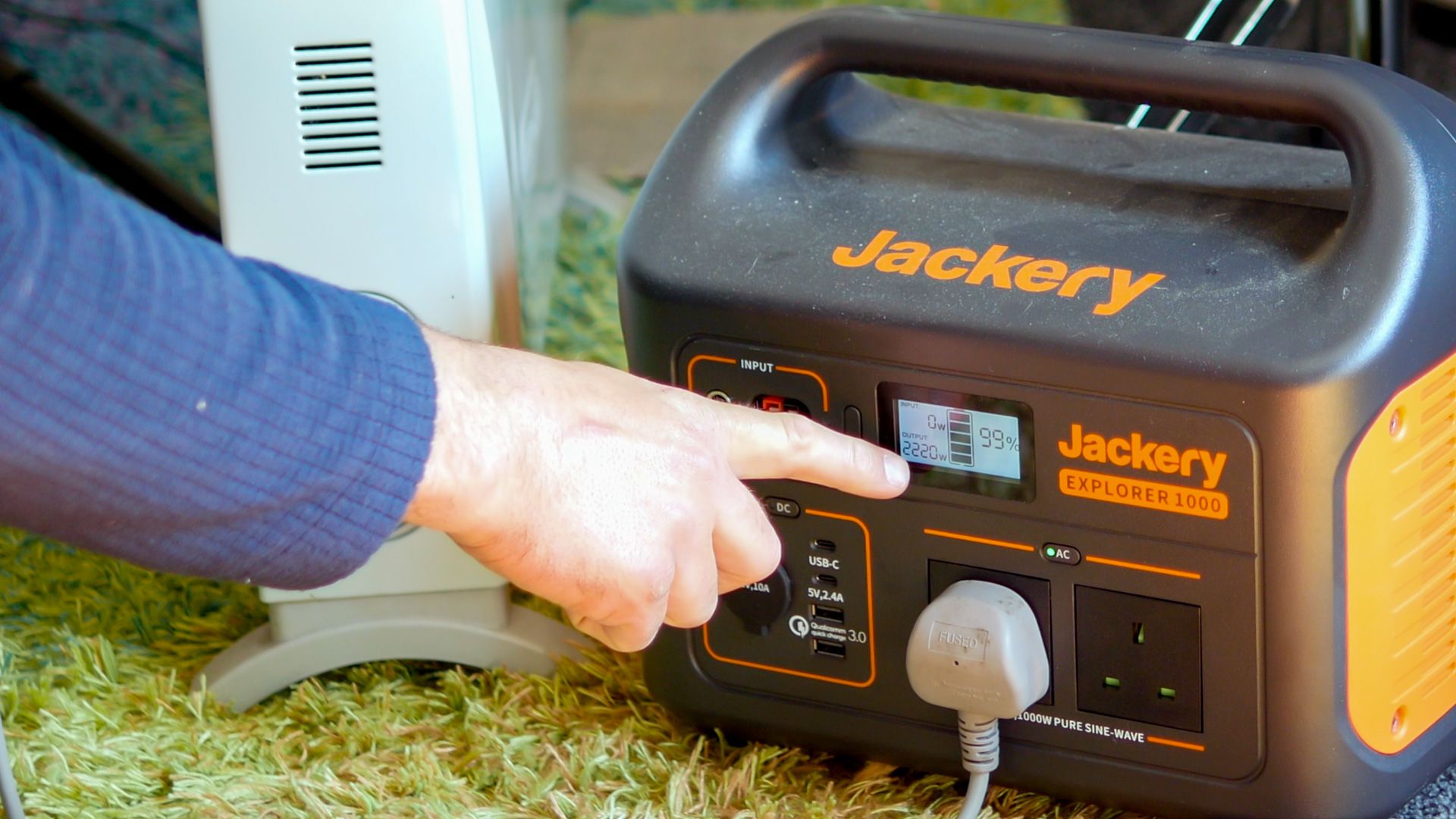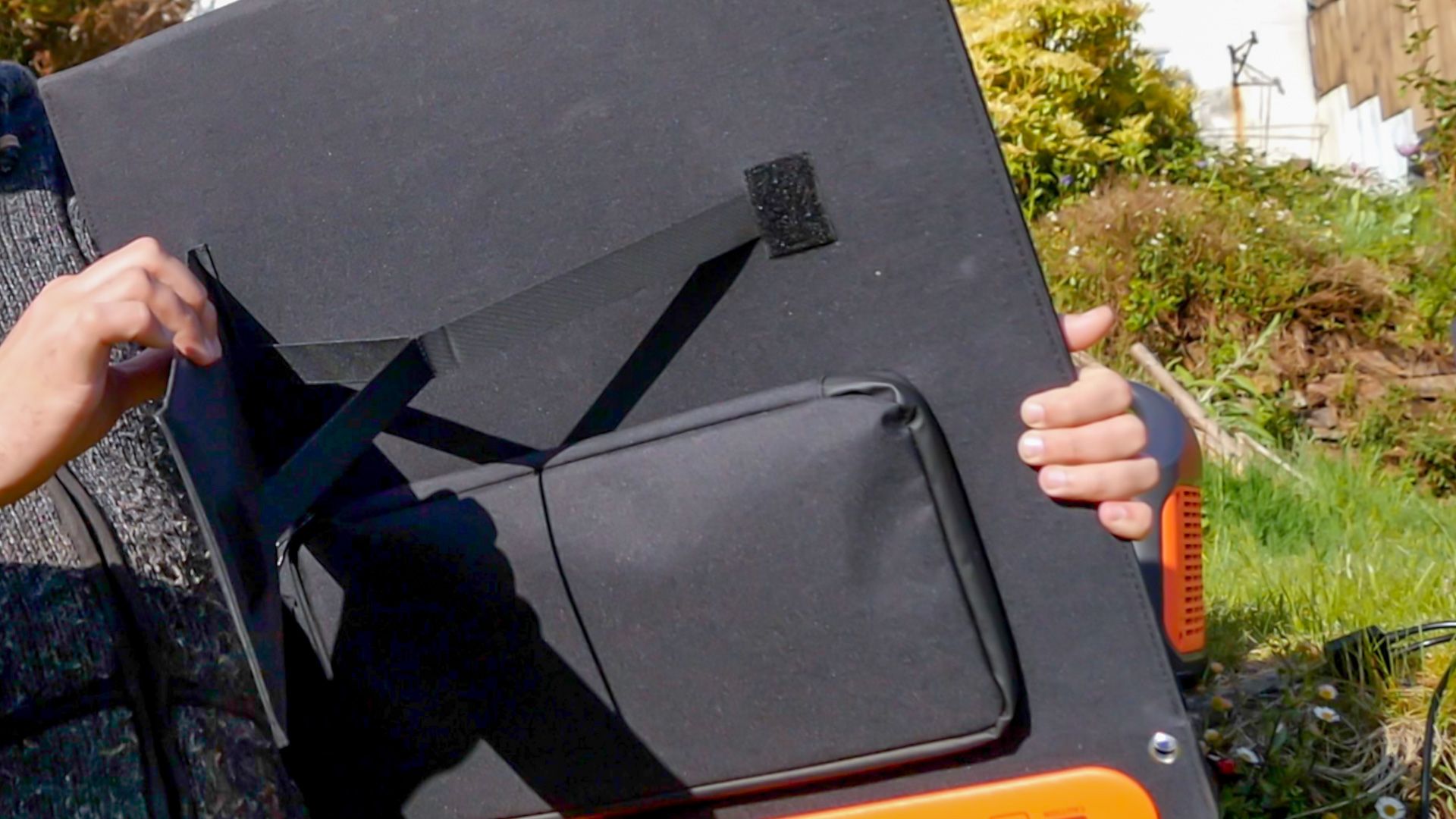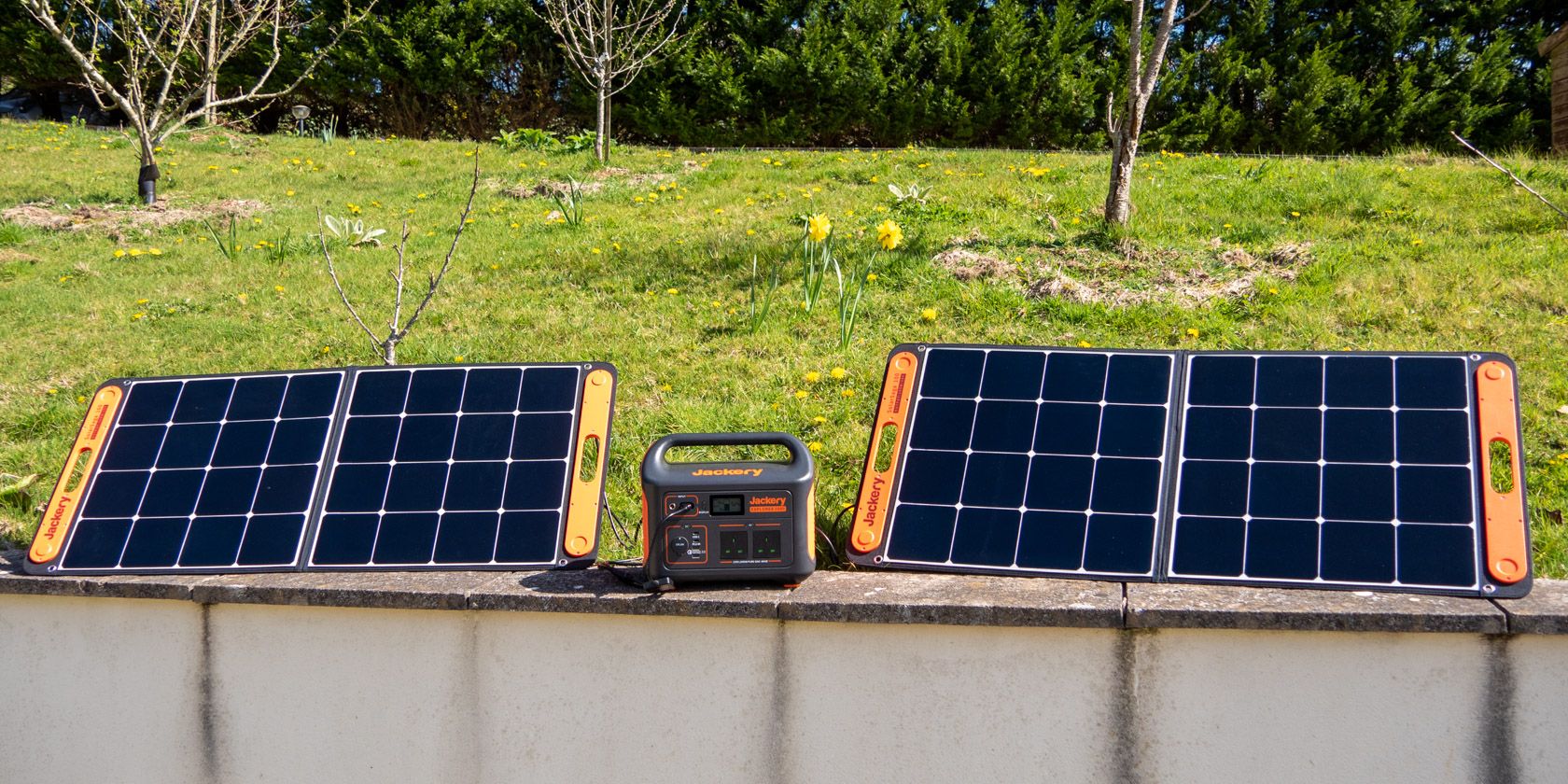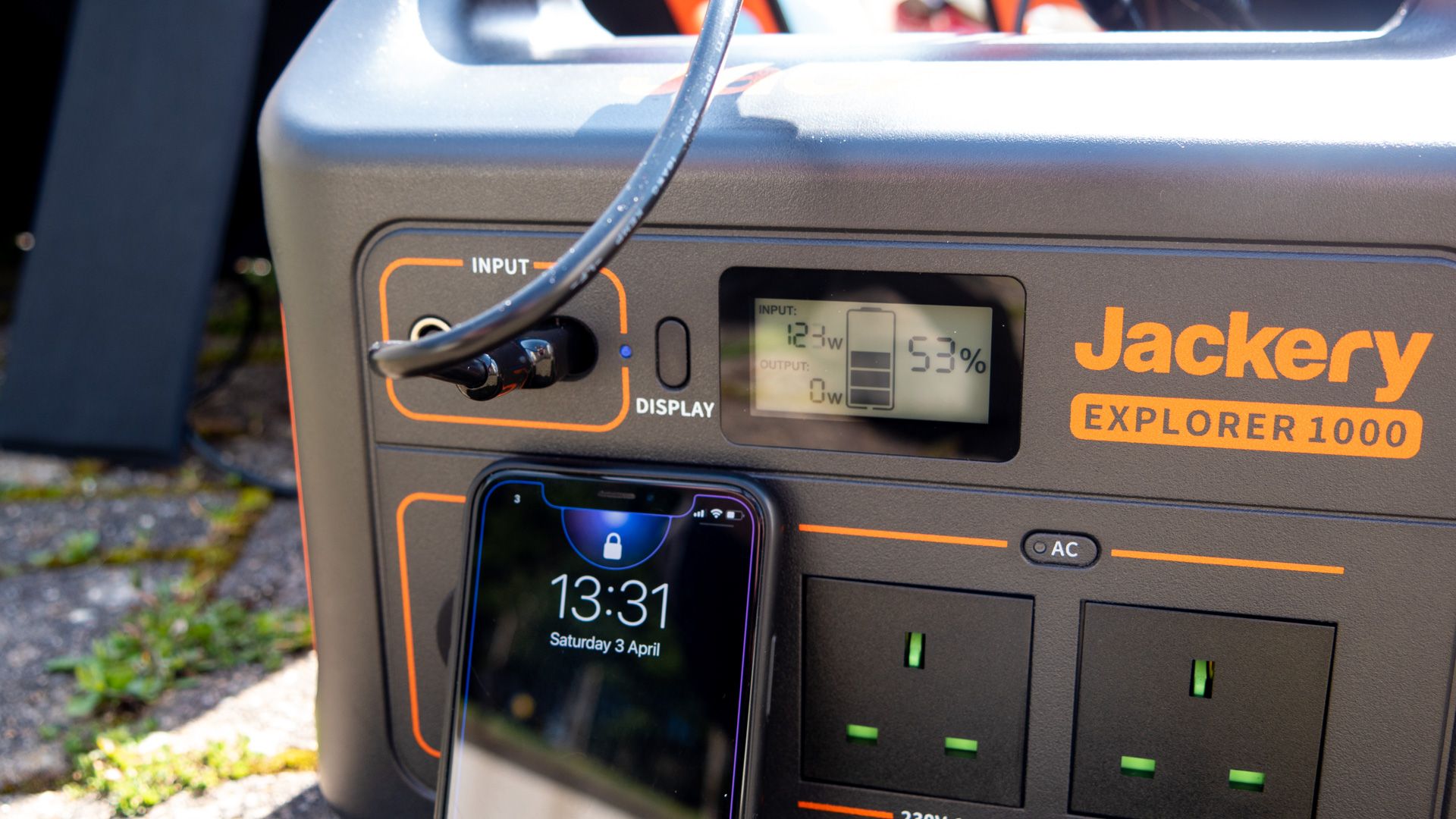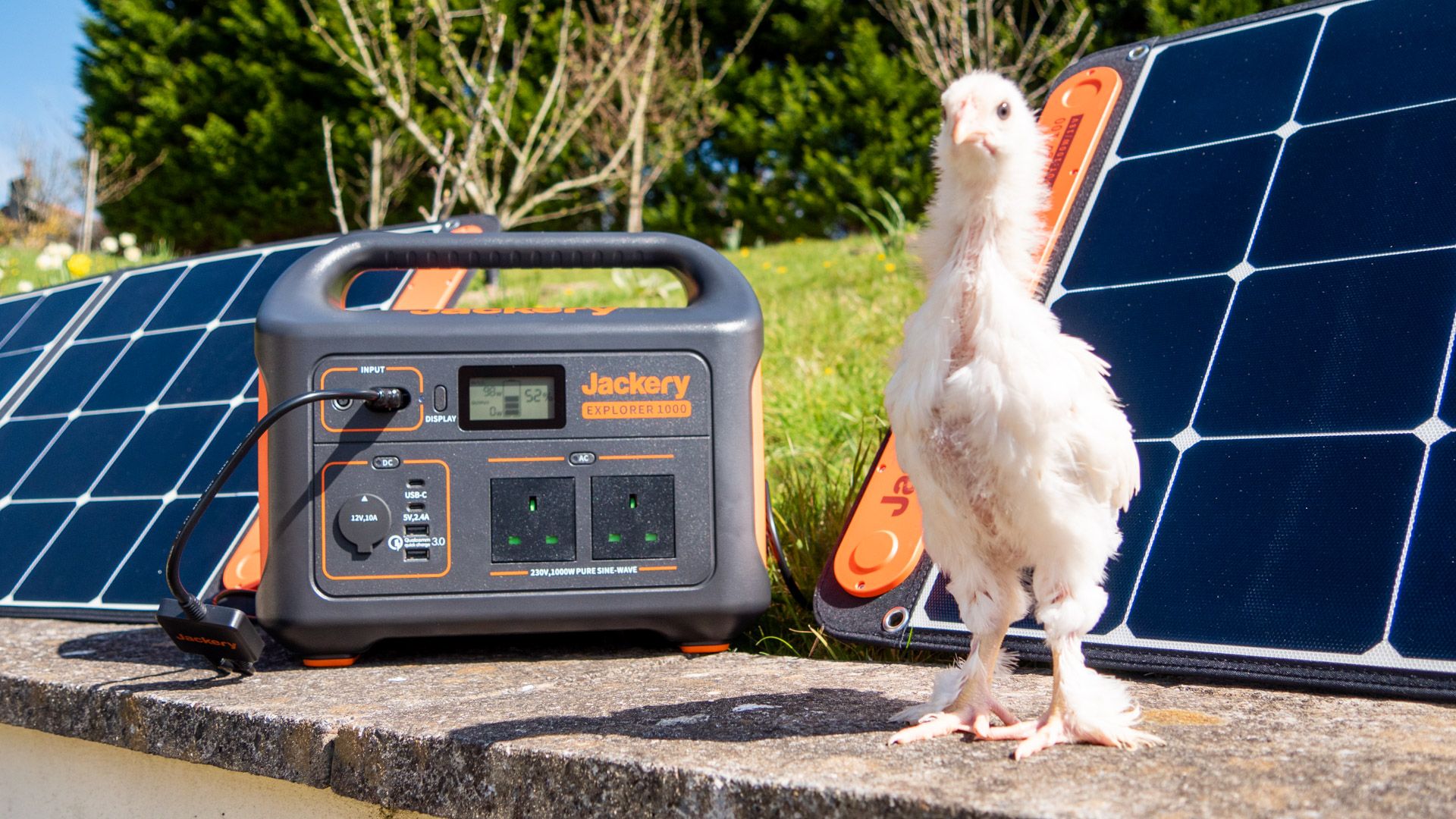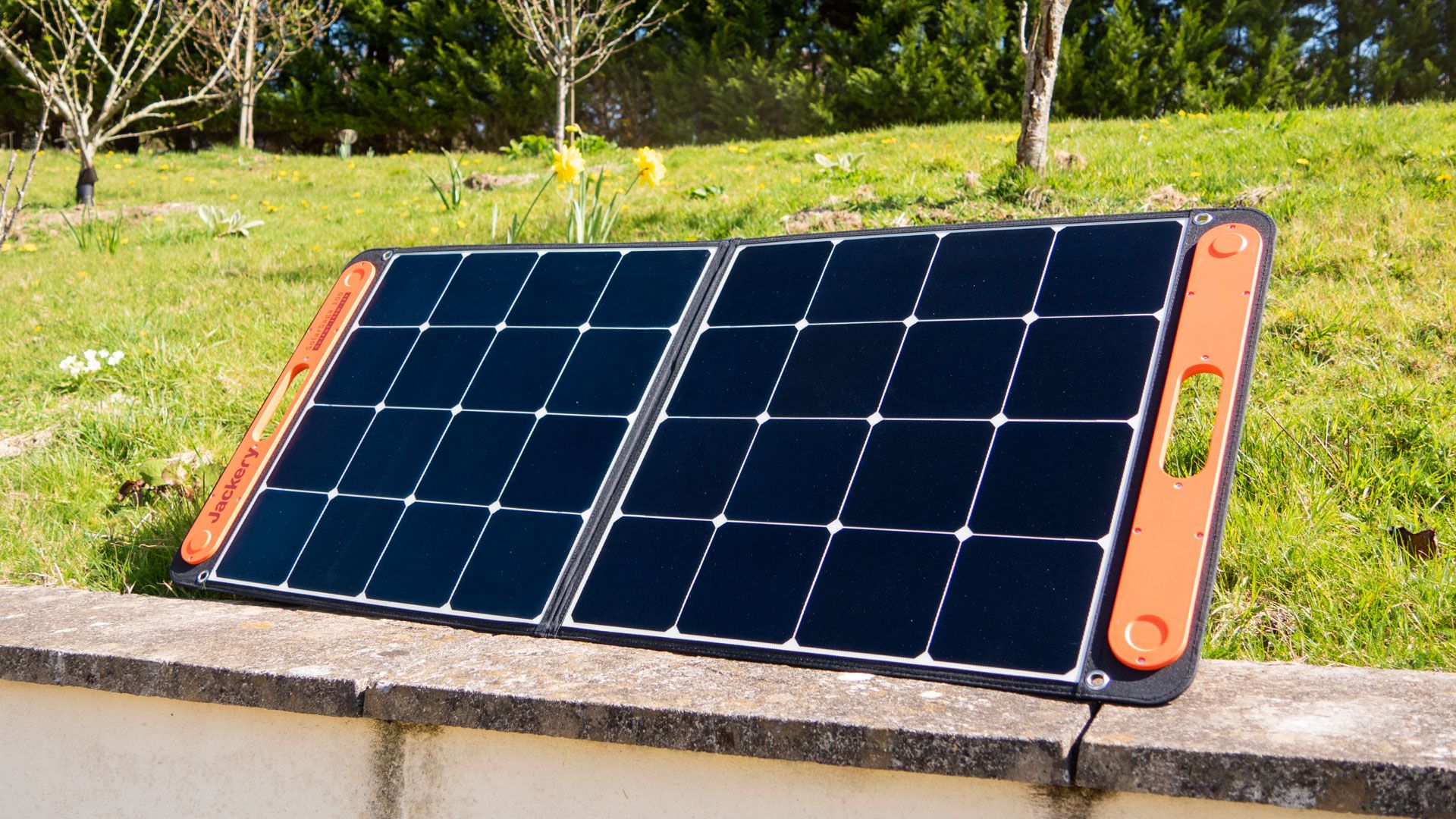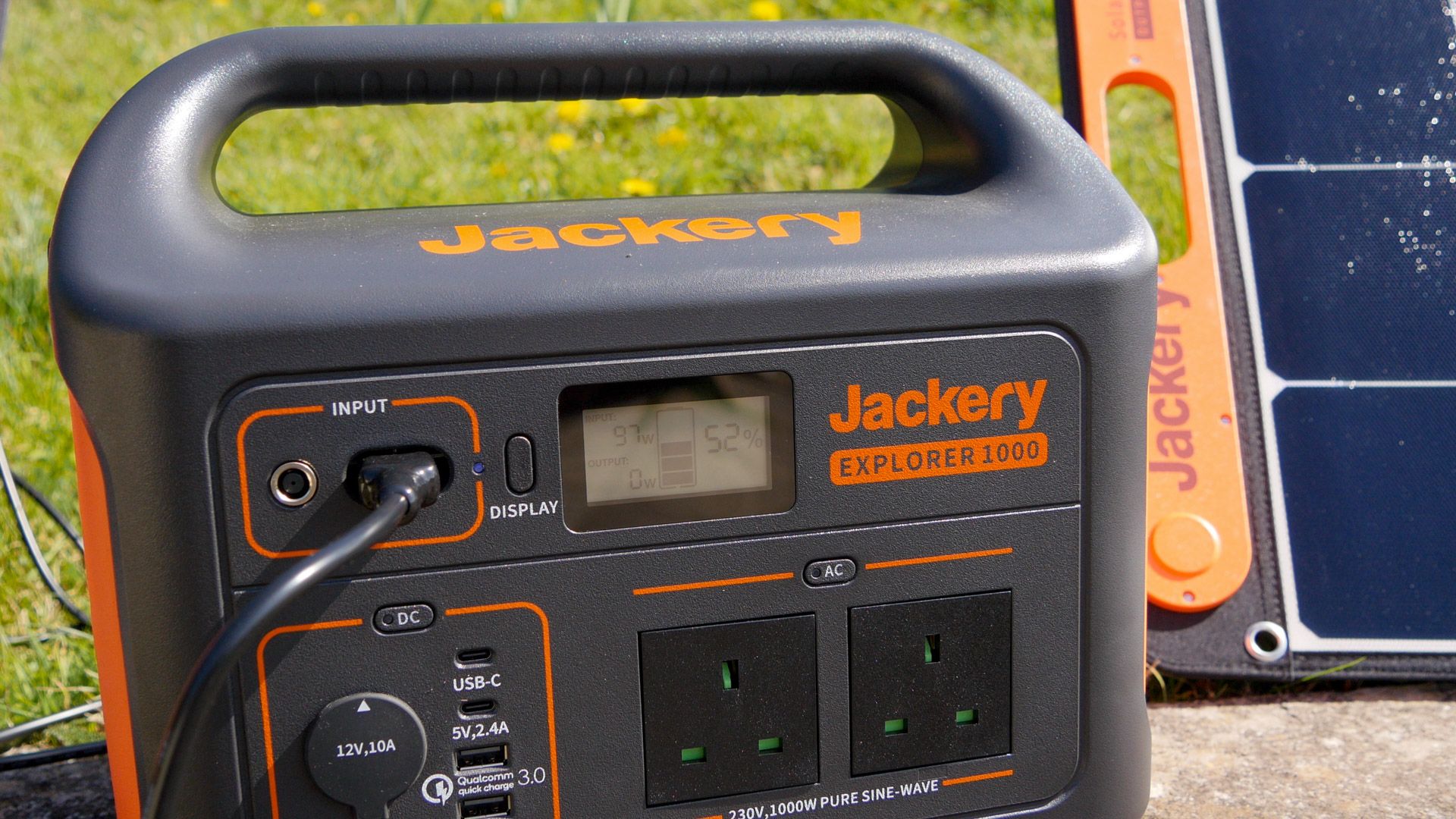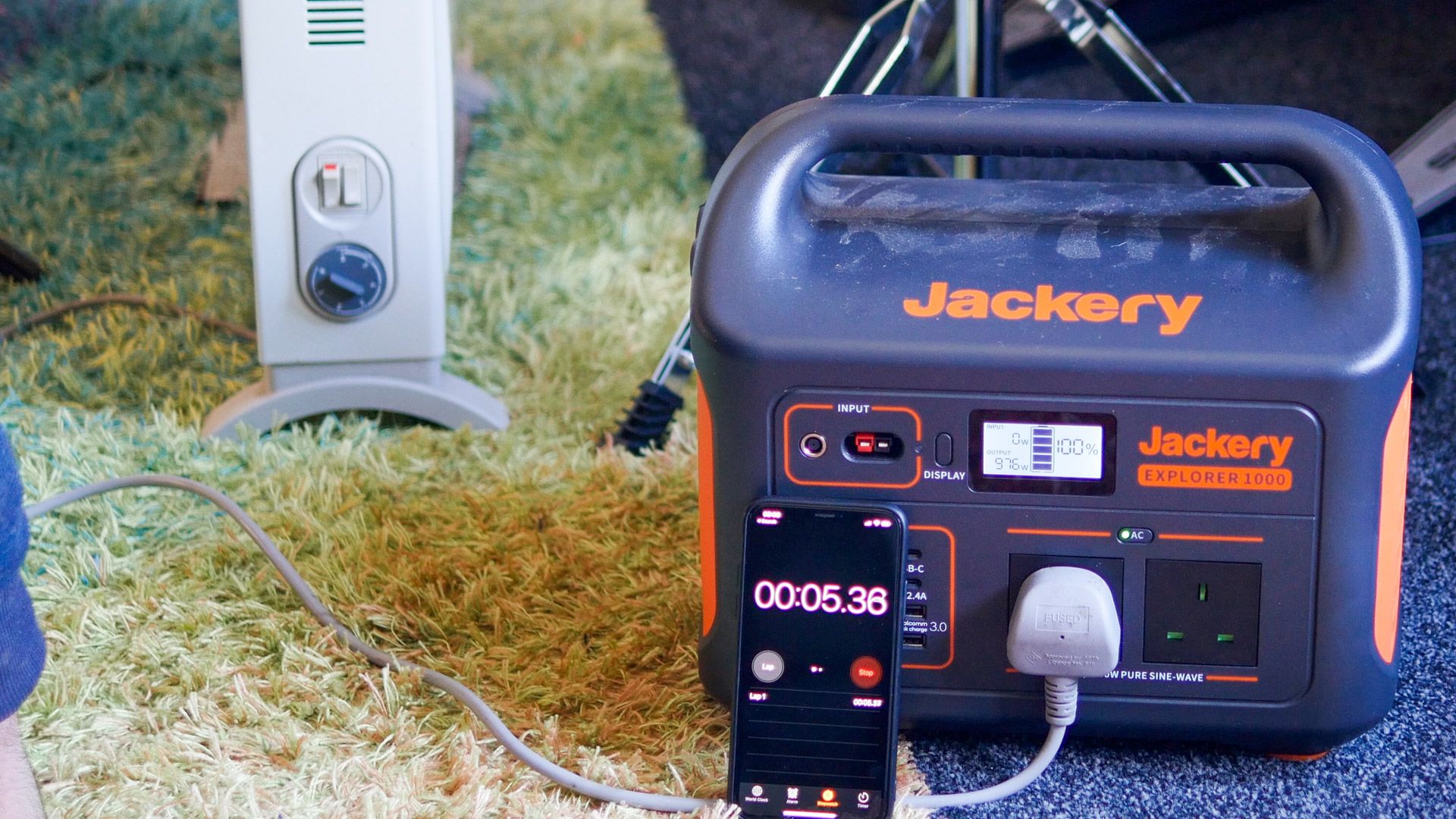Jackery Solar Generator 1000
The Explorer 1000 hits a sweet spot between capacity and convenience. You can still run most higher-powered appliances, like an induction hob or small heater, without struggling to carry it. Combined with the two SolarSaga 100 portable panels, you have a complete off-grid kit to enjoy clean, abundant electrical energy anywhere.
- Brand: Jackery
- Weight: 22lbs (10kg)
- Size: 13.1 x 9.2 x 11.1 inches
- Capacity: 1002Wh
- Maximum Discharge: 1000W continuous / 2000W surge
- Maximum Charge: 200W
- Solar Controller: MPPT
- Output: 2/3 x AC, 2 x USB-C, 2 x USB-A, 1 x 12V car port
- Powers most household appliances
- Great balance between weight and capacity
- One-touch output activation
- Flashlight is unimpressive
- Solar charging from the included panels is limited to 135W
- No Qi-charging or PD
Some people lament that modern life relies on electricity so much—they seem to think we should go back to burning wood and gas stoves. But electricity is a wonderfully clean technology: no smoke, no fumes, no nasty chemicals. Which is fine for charging smartphones, but you can't take enough electricity with you to cook breakfast on when you're in the middle of nowhere, can you?
With the Jackery Solar Generator 1000 set, you absolutely can enjoy an abundant supply of safe, clean, free energy anywhere. Use it for lighting, communication, heating, and even cooking. Whether camping or for a tiny off-grid home, the Jackery Solar Generator 1000 might be just the solution you're looking for.
Is This Really a "Solar Generator"?
If you take issue with these large battery systems being called solar generators, on account of them neither having solar capabilities nor actually generating anything, I sympathize. Instead, they're really just massive batteries with different outputs and can be charged from any DC power source or even a wall socket.
But in this case, the Jackery Solar Generator 1000 is a bundle, consisting of two Jackery Solar Saga 100 portable photovoltaic panels, and a Jackery Explorer 1000 battery. So I think the name is actually justified. When purchased in the bundle, you're saving around $100 compared to purchasing them individually.
Strictly speaking though, the included Jackery Explorer 1000 is not a generator; it is a large battery. However, it does the same job as any traditional backup generator, providing both DC and AC 110/220v output. You can either charge it using the bundled solar panels, which takes about a day for a full charge, or you can use the included AC adaptor (though this isn't particularly quicker), or even charge from your vehicle's 12V car socket.
Jackery Explorer 1000 Hardware
Styled in a distinctive dark grey and orange hard ABS plastic with rubber feet on the underside, the Explorer 1000 feels sturdy—but this shouldn't be mistaken for rugged. It's happy to be used outdoors, but with exposed electrical ports, you absolutely shouldn't get it wet, nor should you pierce the casing. It won't survive a fall, but will otherwise handle the rigors of camping and other outdoor activities.
For ease of transport, the carrying handle is integral to the case design, and cannot be folded away or removed for storage. The overall weight of the battery is a mere 22lbs (10kg), and it measures 13.1 x 9.2 x 11.1 inches.
This feels like a Goldilocks battery size: light enough to carry comfortably while storing enough juice to power the most hungry of electrical needs for a sufficient time. More than 1000Wh and carrying it becomes unwieldy; while lower capacity results in the AC output being essentially useless for all but low power laptop adaptors. The Jackery Explorer 1000 balances capacity and portability perfectly.
On one side you'll find a small emergency flashlight. It's not bright enough to light an entire tent, but would do in a pinch. It has one brightness setting, as well as an emergency broadcast, though oddly it repeats "S O" rather than "S O S". In an emergency, I'm sure it would do ("wait", the mountain rescue leader exclaimed, "that guy is actually signaling so so so, not SOS, let's go home!"), but you'll need a camping light as well.
The assorted of input and output ports, as well as the display panel, adorn the front side of the unit. The LCD panel is basic but functional, displaying a five-segment remaining capacity as well as exact power discharge values. However, I should note that this is the previous generation of display on Jackery devices: newer models like the Explorer 1500 that we reviewed last month have a color display that also displays the estimated time remaining.
Jackery Explorer 1000 Lifespan and Capacity
As the name would suggest, the Jackery Explorer 1000 holds approximately 1000 watt-hours of power. A watt-hour (Wh) is the total amount of power needed to run a one-watt device for one hour. In other words, 1000Wh capacity can theoretically run a 1000-watt device for one hour; or a 100W device for 10 hours; or a 1W device for 1000 hours, etc. I say theoretically because there's always a loss due to conversion inefficiency (wasted as heat, or on fans to cool the battery).
To test this capacity, I plugged in an electric heater that uses just under 1000W on the lowest setting. This is a constant power draw, which makes it ideal for testing. Other appliances such as a fridge fluctuate significantly, drawing more or less power as required (to cool the fridge down again after having opened the door), so it's difficult to draw conclusions with those or make claims such as how many hours the fridge will run for using the Explorer 1000. Given the conversion inefficiencies, I was expecting the 1000W heater to last just under an hour, and sure enough, it cut out at the 55-minute mark. The capacity claim would appear to be accurate.
The Jackery Explorer 1000 uses Lithium Nickel Manganese Cobalt Oxide (NMC) cells which are rated to 500 charge cycles. After this, the capacity is reduced to around 80%. While this is less than Lithium Iron Phosphate cells, it's still a reasonable lifespan. Even if you used a full charge and discharge every day, it would still operate at peak capacity for a year and a half. It won't suddenly stop working after that, it simply won't hold as much charge as new.
To extend the lifespan of the Explorer 1000, you should avoid using charging and discharging features simultaneously, even if it is technically possible. This is not an Uninterruptible Power Supply.
Thankfully, the SolarSaga 100 has separate ports for charging USB devices, so you needn't rely on the battery for topping up smaller devices throughout the day. More on those later.
Explorer 1000 Outputs
The model we've reviewed is for the UK, which has rather large AC ports, so there are only two on this; the US model features three AC outputs.
In addition, you'll find two USB-C ports, and two USB-A ports, running up to 5V 2.4A (QC3.0) max. The USB-C doesn't support the full Power Delivery (PD) spec, so it might not keep an intensive video editing session on a MacBook Pro running, but should otherwise trickle-charge it.
Lastly, there's a 12V car port output (otherwise known as a "cigarette lighter" to us Brits).
Activating any of the outputs on the Explorer 1000 requires only a single press of the appropriate button. This is a lot quicker than competitors where you have to long-press first a power button, then long-press the AC or DC button (then do it again because you were just a fraction of a second off the required button pressing time!)
Compared to similarly specced batteries, the output capabilities of the Jackery Explorer 1000 are also impressive. The maximum continuous output is 1000W, so even running at full whack, it would take one hour to drain it. This is enough for many household appliances and smaller power tools, but not a large kettle or convection oven.
The surge output is a substantial 2000W. This means anything you have plugged can very briefly draw up to 2000W, but shouldn't exceed 1000W in normal continuous usage. The Jackery Explorer 1000 will protect itself from over-discharge (as well as over-charge), but you shouldn't make a habit of plugging in things that are too powerful. I tested this with the electric heater on full power, which surged to 2200W for a few seconds, at which point the Explorer 1000 shut itself off. Lower surge values would last longer before shutting down the unit. Dropping the heater back to low (1000W) power mode, the Explorer 1000 was undamaged and could be easily turned back on again.
Charging the Explorer 1000 with SolarSaga 100
On the input side you'll find both an 8mm DC jack, and an Anderson port. Anderson ports are another connector suitable for higher currents, and are found mostly on Jackery and GoalZero batteries.
The SolarSaga 100 panels provided in this set use an 8mm DC barrel jack as standard. In order to use them both at the same time, Jackery also provides a Y-splitter cable, terminating in an Anderson plug. This connects them together in parallel.
Two panels are provided in the Solar Generator 1000 set, and this is pretty much the limit of what you can use. Although each Solar Saga 100 panel can theoretically output 100W, combining them in parallel to charge the Explorer 1000 results in a maximum of around 135W. This is due to the operating voltage of the panels (18V) and the maximum input current of the battery (7.5A). You might be thinking "why not wire them in series then?", but that would push them over the maximum input voltage of 30V. My testing confirmed this. Individually, each of the panels was consistently putting out 90-100W, both to the Explorer 1000 and other batteries I tested with. Combined, I achieved in the range of 125-130W. This feels like a bit of a mismatch between the panel rating and the charge controller, but it does at least mean a more consistent experience. It will take 8 hours of sun to charge the Explorer 1000 using the two SolarSaga 100 panels—whether that's dismal British sun, or in the middle of a Californian desert.
If you need to charge faster than a day of sun, you should look elsewhere. You should also check panel ratings if you're going to source your own, to ensure it falls under 30V and no more than 7.5A.
The SolarSaga 100 panels are the best portable panels I've seen yet, for a number of reasons.
Featuring a hard plastic handle, they're just a little more durable than the other fully flexible panels on the market and are less likely to contort during transport.
They're a bi-fold design and roughly the size of a small tabletop. Other portable panels tend to be four-fold, which I find to be a little unwieldy, often resulting in undue strain placed on the joints.
The handle integrates magnetic clasps, while other panels typically use a fabric strap to secure the panel in storage. This makes the SolarSaga 100 effortless to set up.
On the rear of the panels is a rigid pull-out flap to act as a stand, which is attached via a three-point fabric strap. Other panels use only a two-point fixing, which often results in the strap dangling out and stopping the stand from re-attaching to the velcro.
Lastly, in addition to the 8MM DC cable to charge the battery, the SolarSaga 100 panels have a USB-C and USB-A port to charge smaller devices directly, located inside the zipped pocket. While this does reduce the overall charge going into the Explorer 1000, it means you're making much more efficient use of the solar. Each time you convert or store energy, you're losing a little to inefficiencies and heat loss, so cutting out the middleman battery is a great idea. It also means you're putting less strain on the cells from simultaneously charging and discharging them, which extends the life of your battery. While you might need to top up smartphones and tablets throughout the day, you can leave the Explorer 1000 for only infrequent use, such as heating or cooking.
Individually, these are all insignificant design features that taken alone wouldn't justify the premium price of the SolarSaga 100. But combined, these features make the SolarSaga 1000 the best portable panel on the market. They're easier to deploy, easier to tidy away, and better for the lifespan of your battery.
Should You Buy The Jackery Solar Generator 1000?
For me, the Explorer 1000 hits a sweet spot between capacity and convenience. You can still run most higher-powered appliances, like an induction hob or small heater, without struggling to carry it.
That said, the Explorer 1000 is a basic portable battery that does what it says on the box, and not a lot else. It can't be daisy-chained to another battery to expand capacity (though that's pretty rare in this market), nor can the internal cells be replaced at the product's end of life. Swappable battery units are also rare at the moment, but we're starting to see them coming to market now, so I suspect Jackery will have their own model with swappable cells by next year.
Although the Explorer 1000 has a small emergency flashlight, it's not particularly bright, and won't replace your need for a camping light. It also doesn't have a Bluetooth speaker either. This might sound like a silly criticism, but I mention it because some batteries do actually feature a Bluetooth speaker, so if you want a more all-in-one portable power supply with all the bells and whistles, this isn't it.
Having USB charging ports directly on the panels is a superb way to use the free energy more efficiently, and combined with other small design features like the bi-fold design and magnetic clasps, makes the SolarSaga 100 the best portable panels you'll find.
Finally, although I've not had cause to contact support, other reviewers note that Jackery generally has better product support than other brands. They may be made in China, but Jackery has a support center in the US, so you're much more likely to get problems dealt with.
Overall, the Jackery Explorer 1000 performs excellently as either an off-grid or emergency power supply. Combined with the two SolarSaga 100 portable panels, you have a complete off-grid kit to enjoy clean, abundant electrical energy anywhere.

